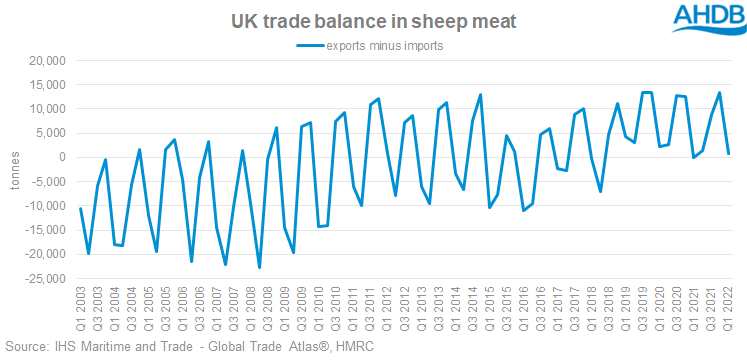UK sheepmeat exports for the first quarter of 2022 performed well, with exports up 19% on the same period as 2021, according to the Agriculture and Horticulture Board (AHDB).
Duncan Wyatt of the AHDB said: “The UK exported 6,600t of fresh/frozen sheepmeat in March, according to data from Her Majesty’s Revenue and Customs (HMRC). This is nearly 300t more than in February, and over 400t more than last March (+7%).
“It brings the year-to-date total to 17,000t, 19% more than at the same point in 2021.”
Of the 17,000t exported so far, 3,200t have gone to France (+12%), 1,300t to Germany (+27%) and 750t to Belgium (+75%). These higher volumes, at a higher average price, mean their value was over £110 million, which is 31% more than a year ago.
“Exports were low in the first months of 2021, as exporters grappled with new trading arrangements and costs following Brexit. Volumes had more or less recovered by April, when high prices for lambs in the UK reduced their competitiveness on the continent, reducing exports again,” Wyatt added.
“This year however, UK lambs remain discounted to those in France and Germany, and so it can be expected that exports will benefit.
“Higher domestic production will not have hurt export volumes either, as exports are strongly correlated to supplies of lambs.”

Imports
Imports however, have declined according to Wyatt.
“Volumes fell in March to 7,000t. This is 600t, or 8% lower than in March 2021,” he said.
“A reduction of 2,000t from New Zealand, which shipped 4,400t, was not quite offset by increases from elsewhere. Irish volumes came to 950t (+500%) and Australian volumes totalled 1,400t (+146%).”
It is worth noting, the analyst added, that the UK-Australia Free Trade Agreement is not yet in force, and so is not responsible for the increase in trade seen so far.
“In the year to date, imports of sheepmeat are 16,000t, 12% more than a year ago. Exports have been higher than imports,” Wyatt added.
“This is increasingly common as domestic production exceeds demand on what may become a year-round basis, rather than only in the autumn.”

